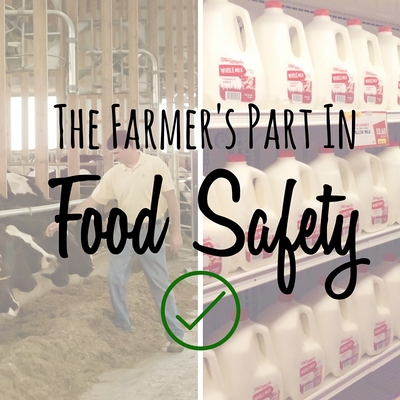The Farmer's Part in Food Safety
Posted: 11/3/2015
 |
| Right Photo: Flicker / Mike Mozart |
By: Rebecca Christman
You may have seen news coverage or social media posts about food safety and antibiotics in livestock production lately. You might be wondering whether that means the food you purchase for your family is safe. I’m happy to say that the short answer is “yes.” The long answer is that it takes dedicated efforts across the entire food chain – from farmers all the way to consumers – to ensure that the U.S. food supply is one of the safest and most affordable in the world.
Americans spend only nine percent of their income on food, compared to fifteen percent or more in other countries. Our food system in the US is also highly regulated, which ensures that the food you are eating is not only low cost, but safe.
Farmers are doing their part too, by making sure that animals stay healthy. On our farm this includes making sure that animals are fed a healthy diet, providing a clean place for them to live, giving them shelter when needed, and also giving vaccinations when cattle are young. As a child, I remember getting a series of vaccines before I entered kindergarten. Similarly, the vaccinations we give prevent diseases that are common to cattle.
Farmers work very hard to ensure that their animals stay healthy. Despite this, occasionally animals do get sick. If an animal on our farm does get sick, we work with a veterinarian to decide on the right course of treatment. Sometimes, that is an antibiotic. As in humans, there are some conditions that we know won’t respond to antibiotics. Farmers do their best to be judicious with the use of antibiotics and the entire agriculture industry is looking for ways to improve. Many of the antibiotics used in animals are rarely used in humans and vice versa. Check out this chart comparing human and livestock antibiotic use (also below). In fact, humans and their pets use more ten times more antibiotics than animals in livestock production.
 |
For those animals that do need an antibiotic to get better, there are strict regulations ensuring that meat or milk does not enter the food supply until the drug is completely out of the animals system. This is a called a “withdrawal period”, and the withdrawal period for each antibiotic is clearly listed on the product label. Off the farm, products are routinely tested by the FDA to ensure that no residues of the antibiotic are present in the food we are eat.
Despite many products being labeled “antibiotic free” the truth is that there are no antibiotic residues in ANY of the meat or milk you consume, regardless of what the label says. Next time you go to the grocery store you can be sure that whatever product you are buying, regardless of label, is safe for your family.
Food safety may begin with the farmer, but it ends with all of us as consumers. Putting the milk in the fridge right away when you get home from the store, properly thawing meat when you take it out of the freezer, and putting leftovers in the fridge within two hours of taking them out of the oven are all things we need to do at home to keep food safe. Clean, separate, cook, and chill, are easy steps to ensure food safety at home.
From the farmer to your fridge, food safety is a priority for all involved.
Listen to this week's Farmer's Daughter radio segment here! FARMERS_DAUGHTER-_NOV_2ND.mp3

Comments
blog comments powered by Disqus